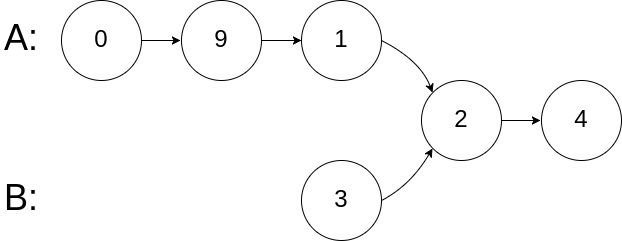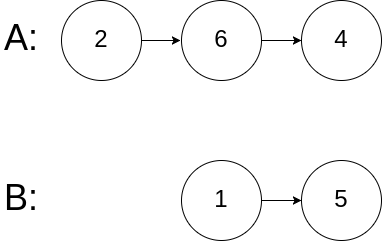160. 相交链表
编写一个程序,找到两个单链表相交的起始节点。
如下面的两个链表:

在节点 c1 开始相交。
示例 1:

输入:intersectVal = 8, listA = [4,1,8,4,5], listB = [5,0,1,8,4,5], skipA = 2, skipB = 3
输出:Reference of the node with value = 8
输入解释:相交节点的值为 8 (注意,如果两个列表相交则不能为 0)。
从各自的表头开始算起,链表 A 为 [4,1,8,4,5],链表 B 为 [5,0,1,8,4,5]。
在 A 中,相交节点前有 2 个节点;在 B 中,相交节点前有 3 个节点。
示例 2:

输入:intersectVal = 2, listA = [0,9,1,2,4], listB = [3,2,4], skipA = 3, skipB = 1
输出:Reference of the node with value = 2
输入解释:相交节点的值为 2 (注意,如果两个列表相交则不能为 0)。
从各自的表头开始算起,链表 A 为 [0,9,1,2,4],链表 B 为 [3,2,4]。
在 A 中,相交节点前有 3 个节点;在 B 中,相交节点前有 1 个节点。
示例 3:

输入:intersectVal = 0, listA = [2,6,4], listB = [1,5], skipA = 3, skipB = 2
输出:null
输入解释:从各自的表头开始算起,链表 A 为 [2,6,4],链表 B 为 [1,5]。
由于这两个链表不相交,所以 intersectVal 必须为 0,而 skipA 和 skipB 可以是任意值。
解释:这两个链表不相交,因此返回 null。
注意:
如果两个链表没有交点,返回 null.
在返回结果后,两个链表仍须保持原有的结构。
可假定整个链表结构中没有循环。
程序尽量满足 O(n) 时间复杂度,且仅用 O(1) 内存。
来源:力扣(LeetCode)
链接:https://leetcode-cn.com/problems/intersection-of-two-linked-lists
著作权归领扣网络所有。商业转载请联系官方授权,非商业转载请注明出处。
思路1
遍历链表 A,将 A中节点对应的指针(地址),插入 set
遍历链表 B,将 B中节点对应的指针(地址),在 set 中查找,不返回 end()的第一个 地址,即交点

1 class Solution { 2 public: 3 ListNode *getIntersectionNode(ListNode *headA, ListNode *headB) { 4 set<ListNode*> node_set; 5 while (headA) { 6 node_set.insert(headA); 7 headA = headA->next; 8 } 9 while (headB) { 10 if (node_set.find(headB) != node_set.end()) { //find()没找到,返回 end() 11 return headB; 12 } 13 headB = headB->next; 14 } 15 return NULL; 16 } 17 };
思路 2
计算链表长度和长度之差

将长链表指针移动到和短链表对齐

headA 和 headB 同时移动,直到两指针指向同一节点

1 class Solution { 2 public: 3 ListNode *getIntersectionNode(ListNode *headA, ListNode *headB) { 4 int list_A_len = getListLength(headA); 5 int list_B_len = getListLength(headB); 6 if (list_A_len > list_B_len) { 7 headA = forwardLongList(headA, list_A_len, list_B_len); 8 } else { 9 headB = forwardLongList(headB, list_B_len, list_A_len); 10 } 11 while (headA && headB) { 12 if (headA == headB) { 13 return headA; 14 } 15 headA = headA->next; 16 headB = headB->next; 17 } 18 return NULL; 19 } 20 private: 21 //计算链表长度 22 int getListLength(ListNode* head) { 23 int len = 0; 24 while (head) { 25 ++len; 26 head = head->next; 27 } 28 return len; 29 } 30 31 //将长链表指针向后移动,返回对齐后的位置 32 ListNode* forwardLongList(ListNode* long_head, int long_len, int short_len) { 33 int delta = long_len - short_len; 34 while (long_head && delta) { 35 long_head = long_head->next; 36 --delta; 37 } 38 return long_head; 39 } 40 };
测试

1 int main(int argc, const char * argv[]) { 2 ListNode a1(1); 3 ListNode a2(2); 4 ListNode b1(3); 5 ListNode b2(4); 6 ListNode b3(5); 7 ListNode c1(6); 8 ListNode c2(7); 9 ListNode c3(8); 10 a1.next = &a2; 11 a2.next = &c1; 12 c1.next = &c2; 13 c2.next = &c3; 14 b1.next = &b2; 15 b2.next = &b3; 16 b3.next = &c1; 17 18 Solution solve; 19 ListNode *result = solve.getIntersectionNode(&a1, &b1); 20 cout <<result->val; 21 22 return 0; 23 }



